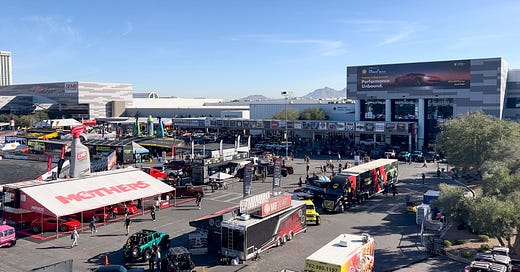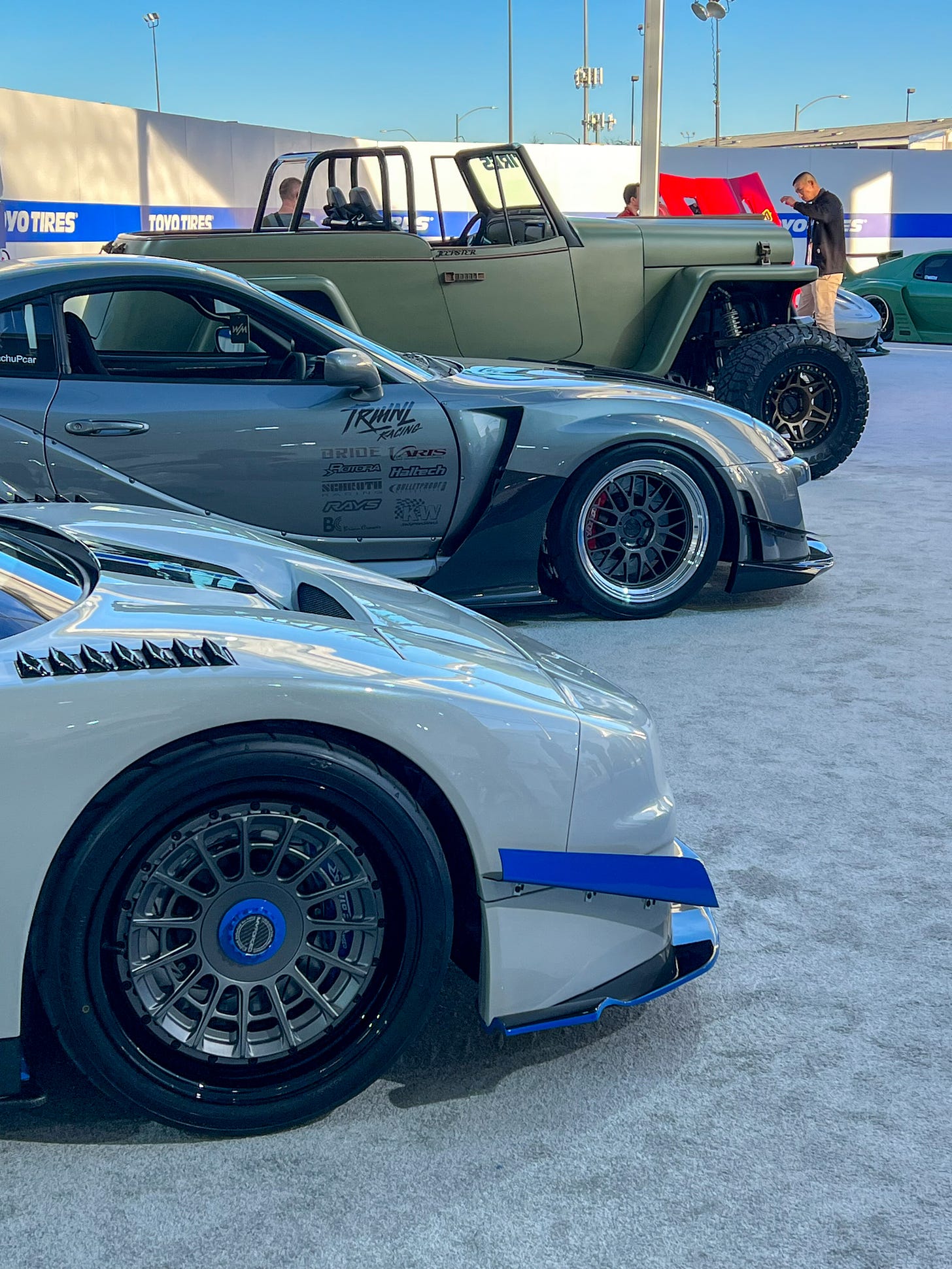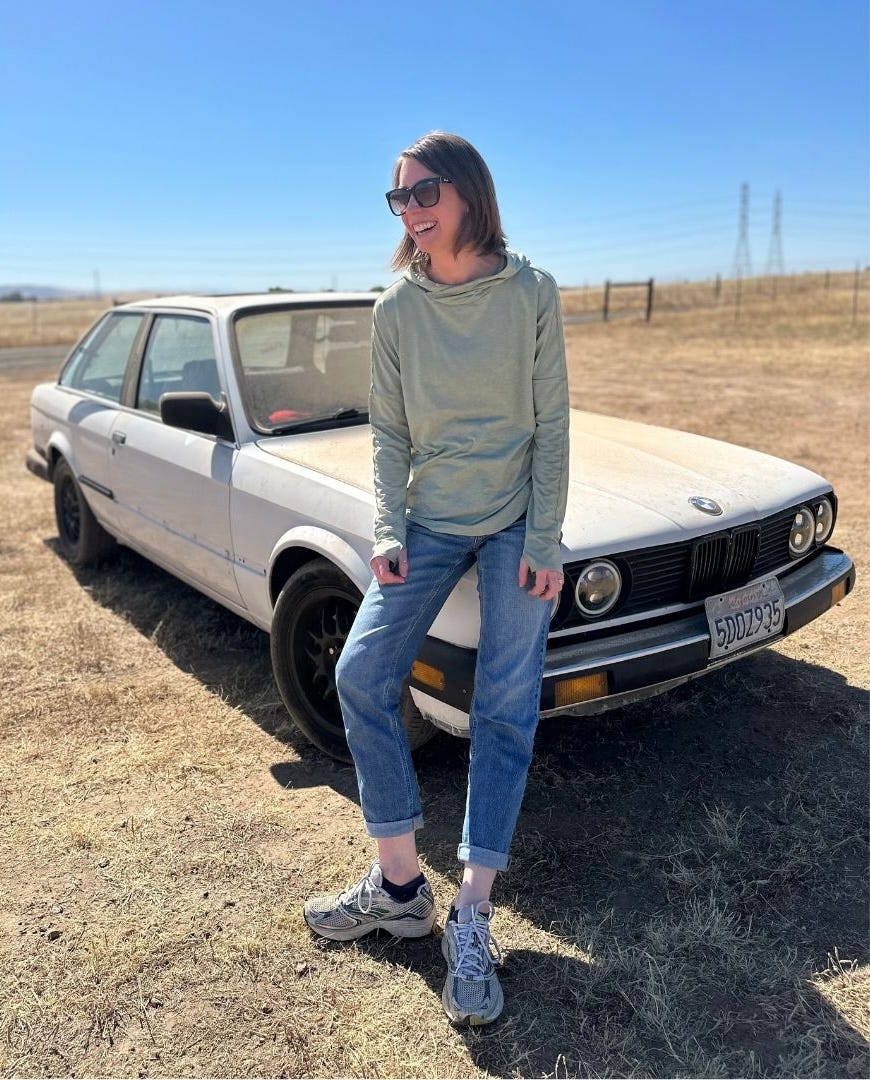Who's Really Winning in the Aftermarket?
The latest industry report from SEMA reveals some interesting trends
HAPPY RACE DAY! especially to our good friend Mickey Andrade, a crucial source of information during my research for Cult of GT-R and an all-around wonderful, genuine person. Mickey announced yesterday on YouTube that he was diagnosed with throat cancer earlier this year. But today, he is cancer-free! We are thrilled to hear this news and wish Mickey and his family all the best. Hope to see you soon, brother.
In today’s email: 👇
The Shaky Aftermarket: How a $50B industry hit a wall
Media Rights and Motorsport: Q&A with journalist Olivia Hicks
Update on Your Mom: Catch up with our favorite rallier
Here’s this week’s top story.
As SEMA Approaches, Sales are Up But Brands are Scrambling
Things appear to be dandy in the aftermarket world. As we begin to leave summer in the rearview mirror, you can almost feel the annual SEMA Show coming to Las Vegas in November looming on the horizon. This should be a big year. After all, segments like off-roading SUVs are booming, consumer spending could get a boost as the Fed considers cutting rates, and the industry’s own recent report said annual aftermarket spending grew to $52.35 billion (with a B) in 2023. It’s smooth sailing.
Well, maybe. There’s a lot going on under the surface. It’s turns out that that $52.35B figure is only a one-percent increase over 2022 sales. And what’s more, the bulk of that growth appears to have come from only a small handful of massive corporations. The small guys, as I reported from the show floor last year, felt the squeeze. After a COVID spending boom while everyone stayed home, the SEMA report called it “not surprising” to see some companies experience a slowdown in 2023.
“We’re seeing a lot more now in EV component manufacturers.” SEMA President Mike Spagnola on The InEVitable podcast.
The truth is that the aftermarket is going through a monumental shift. An industry that built its back on hard products like wheels, exhaust systems and off-road lift kits is bracing itself for an electric future. The SEMA report predicts exponential growth in electric vehicle sales beginning in 2030. “The last couple years we’ve tried to foster all vehicle technologies,” SEMA President Mike Spagnola told The InEVitable podcast earlier this month. “We’re seeing a lot more now in EV component manufacturers.” Combine EVs with hybrid, plug-in and fuel cell vehicles, and the normally-conservative SEMA expects sales of gas-powered cars to barely account for half the new car market by 2035.
This is a big challenge, but it also presents big opportunity. To channel our inner Palo Alto, the aftermarket is ripe for disruption. Companies are beginning to shift their thinking toward EV applications, like upgraded cooling systems and automated driver safety (ADAS) systems. Those ADAS systems, such as backup cameras and collision sensors, only accounted for $780 million of the aftermarket in 2023. But a whopping 76% of manufacturers in the segment saw growth last year, according to SEMA. That’s far more than typical in a year where most companies struggled to increase sales. Other segments like clutches, exhaust and turbochargers only reported growth from 30-40% of manufacturers.
That suggests that aftermarket brands in the EV and ADAS space are bubbling with potential. And that presumably makes the aftermarket very appealing to one corner of the financial world: private equity. A recent report from the consulting firm McKinsey found that the aftermarket is primed for M&A, or mergers and acquisitions, from large companies that can shovel money into research and development. The bulk of aftermarket profits are already going to only a few players. So as the industry consolidates, companies will need scale in order to survive, the report said. Look at examples like Edelbrock and Holley Performance, legacy brands both owned by private equity firms, and both aggressively gobbling up aftermarket brands in recent years to increase market share.
It will be a long time before the SEMA show floor has gone fully-EV. Muscle cars and off-road trucks still drive a lot of business, and there’s reason to be optimistic that spending will increase this year. (Half of aftermarket customers in 2023 were under 40, after all.) Whatever changes the aftermarket encounters in the next decade, don’t worry — turbo kits aren’t going anywhere.
Ask A Gen Z! Olivia Hicks, 23
Ask A Millennial! is getting harder these days, and Gen Z-ers like Olivia are one of the reasons why. On her newsletter Formula Flash, the journalist brings her intrepid style of reporting to an industry that’s grown accustomed to showering praise. Recently, her posts on a near-earthquake in media rights and the role of fossil fuel advertising stood out for their thorough research and business perspective. We caught up with Olivia to learn more. Here is an edited version of our conversation:
Readers on Substack are open to my post topics, they subscribe for a reason after all. The response from media outlets is where things get a bit hazy. Before I began freelancing full-time, most of my stories were exclusively meant for Substack. With my workload now, lots of the stories I pitch to editors either get no response or minimal interest. They end up reshaped for Substack. I’ve found it difficult to get the mainstream media to care about motorsport and its global impacts. It’s equally difficult to snag the motorsport media’s attention off the track.
The fact that these are undercovered or untouched topics naturally makes me ask “Why isn’t anyone talking about this?” Motorsport isn’t alone in blurring the lines between editorial and advertising, but it’s a small world that tends to enjoy gifting journalists little excursions, dinners or swag bags. I come from a journalism background where accepting a cup of coffee raises eyebrows. It’s this constant ethical tightrope that’s worn thin with the advent of content creators who create wonderfully engaging social content but often don’t think twice about taking sponsorship money. There are still plenty of talented motorsport journalists asking hard questions, but there’s no denying the shift in sports journalism and reality of how paddocks operate—traveling around the world with the same group of people who you are reporting on—chips away at the prospect of diving into those stories.
A journalism professor in college once told me reporters have to constantly be on, looking for potential stories even while grocery shopping. While gossiping and eavesdropping labeled as“work” sounded great to me, my immediate thought was that it seemed exhausting. My hunt for environmental stories often felt like that. I’ve been lucky with motorsport that stories have come to me naturally, piquing my curiosity without too much strain. Social media, for example, is where I kept stumbling across female Formula 1 fantasy players. That led to a handful of questions that led to research that led to the realization that this is novel and hasn’t been covered.
I heard about Venu Sports and then scoped out what had been written on the topic and went from there. The story began with a hunch that this would be bad for IndyCar whether it signed a rights deal with NBC or Fox. Once I did a little digging it became obvious that it would resemble a motorsport monopoly, with a whole sport nearly wiped from streaming and cable. A source who works in antitrust law for the U.S. government was able to provide background. It then takes a few drafts to piece everything together and publish.
One of the many, many things I’ve learned over the last year is that the money behind motorsport really draws me in: Where it’s coming from, who it’s going to, how people are spending it and why it fuels not just the cars, but the world around motorsport. It has always struck me as odd that Formula 1’s influence isn’t talked about as widely. It’s a sport full of billion-dollar bottom lines, Saudi princes and fuzzy tax laws. I love race reports and want to expand my freelancing to more on-track action, but my real love (and future, I hope) lies in following the money.
For more fantastic women motorsport writers on Substack, check out:
Grand Prix Gastronomy by Elizabeth Blackstone
Track Limits by Sara Neves
But Do You Actually Like Sport? by Molly McElwee
Inboxbox by Sasha Rogelberg
And Finally…
OUR GOOD FRIEND Kelly Conroy continues her adventures in rally racing, which you can follow on Instagram under her handle @yourmomracesrally. In recent weeks she’s learned to weld, changed the CV joints and put her brand new protective skid plate to the test. Expect much more from this project as Your Mom Motorsports marches toward its inaugural race!
Thanks for reading. Please consider sharing our newsletter with your friends.
Check out Carrara Media on Instagram, Twitter and Facebook and visit our store to order one of our many fine books and eBooks.








Thanks for having me, Ryan!